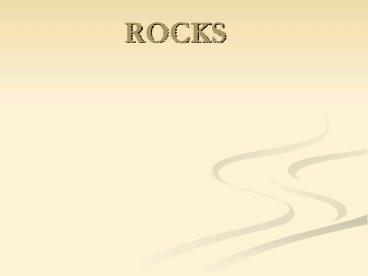ROCKS - PowerPoint PPT Presentation
1 / 27
Title:
ROCKS
Description:
ROCKS What is a rock? What is a rock? Made of entirely one mineral or several minerals. Could contain organic matter (composed of living material, usually carbon ... – PowerPoint PPT presentation
Number of Views:198
Avg rating:3.0/5.0
Title: ROCKS
1
ROCKS
2
What is a rock?
3
What is a rock?
- Made of entirely one mineral or several minerals.
- Could contain organic matter (composed of living
material, usually carbon based). - The chemical make-up of the rock may vary from
one sample to another.
4
Types of Rocks
- What are the three classes of rocks?
5
Types of Rocks
- What are the three classes of rocks?
- 1. Igneous Rocks
- 2. Sedimentary Rocks
- 3. Metamorphic Rocks
6
Igneous Rocks
- Name comes from the Latin word ignis meaning
from fire. - Formed when super hot magma or lava cools.
- There are seven different classes based on
chemical composition of the igneous rock.
7
Types of Igneous Rocks
- Extrusive Igneous Rocks
- Formed from lava that quickly solidifies at the
cooler surface. - Produces fine-grained rocks.
- Ex. basalt and rhyolite
david-amador.com
geology.com
8
Types of Igneous Rocks
- Intrusive Igneous Rocks
- Trapped magma under the crust solidifies slowly.
- Intrusive rocks are composed of larger crystals
because form slower. - Larger crystals give these rocks a rougher
texture - Ex. granite
- Mount Rushmore is carved from granite in the
Black Hills of South Dakota.
Mount Rushmore is carved from granite in the
Black Hills of South Dakota.
9
Igneous Rock
- The most common known igneous rock is granite.
- It is composed almost entirely of feldspar and
quartz
10
Igneous Rocks Mafic vs. Felsic
- Felsic chemically composed of potassium,
feldspar, and large amounts of quartz.
- Mafic chemically composed of iron and
magnesium, and smaller amounts of quartz.
csmres.jmu.edu
11
Bell Ringer Rocks
- What is the difference between intrusive and
extrusive igneous rocks? - T or F Intrusive igneous rocks are composed
of larger crystals then extrusive igneous rocks. - Would mafic or felsic magma be magnetic? Explain
your answer.
12
Igneous Rock Formations
- Extrusive Igneous Structues
- volcanoes
- Intrusive Igenous Structures
- batholiths
- laccoliths
- sills
- dikes
indiana.edu
13
Sedimentary Rocks
- All sedimentary rocks are made of materials
called sediments deposited by natural and
chemical processes. - Sediments become cemented or compacted together
over time forming a solid rock
Uluru (Ayers Rock) in Australia, the world's
largest monolith, is made of sandstone.
14
Types of Sediments
- Tiny grains of sand
- Broken pieces of rock along the bottom of a
stream - Fragments of seashells
- Layers of mud
- Organic matter (plant and animal remains)
15
Sediments and Sedimentary Rocks
- Gravity, water, or wind carries them to a
destination. - Sediments deposit in layers over time. (strata
layers) - Loosely deposited sediments eventually form a
solid rock by - 1.Compaction sediments squeezed together by
gravity/pressure. - 2. Cementation sediments glued together by
minerals deposited by water.
16
Sedimentary Rock
- The most common sedimentary rock is limestone.
- Develops from living remains (shells, mollusks)
- Coal is another example of a sedimentary rock
derived from organic remains.
17
Sedimentary Rock
Ripple marks formed in the sand by wind
- Often preserve some characteristics from which
they were formed. - Ripple marks formed in the sand will appear in
the rock formed from the sand deposits.
18
Sedimentary Rocks
- The source of most fossil remains.
- The age of a rock can be determined by studying
the fossils within it.(Radiometric Dating) - Identify when prehistoric organisms and
vegetation thrived and became extinct.
Fossilized Leaves
19
Sedimentary Rocks
- The diverse colors within the sedimentary layers
(strata) gives scientists an idea of their
chemical make-up. - The red and pink bands in the Grand Canyon
exhibit the iron found in the sediment.
20
Sedimentary Rocks Location
- Sedimentary rocks cover almost all of the ocean
floor and about three-fourths of Earth's surface
land area.
21
Metamorphic Rock
- Metamorphism change in the chemical make-up of
rocks - Heat, pressure, and hot fluids cause rocks to
change into other rocks. - Where would this most likely occur?
22
Metamorphic Rock
- Heat, pressure, and hot fluids cause rocks to
change into other rocks. - Where would this most likely occur? within the
Earth - at subduction zones
23
Metamorphic Rock
Formed from compression of Tectonic plates
The geologic processes that created the North
Cascades changed the original rock into
metamorphic rock.
24
Types of Metamorphic Rock
- Slate is a common form that is easily split into
slabs - Gneiss (pronounced nice) contains light and
dark bands - Granite is also a common type
25
The Rock Cycle
- Almost all of the rocks that compose the Earths
crust today are made of the same stuff as the
rocks that dinosaurs and other ancient life forms
walked, crawled, or swam over. While the
stuff(matter) that rocks are made of has changed,
the rocks themselves, have not. Over time rocks
are recycled into other rocks.
26
The Rock Cycle
27
The Rock Cycle































